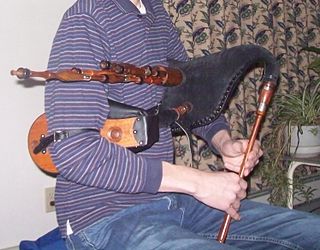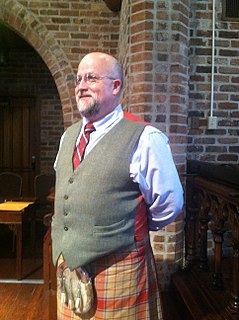This article needs additional citations for verification .(July 2018) |

The Zetland pipes were a type of bagpipe designed and crafted by Pipe Major Royce Lerwick in the 1990s.
This article needs additional citations for verification .(July 2018) |

The Zetland pipes were a type of bagpipe designed and crafted by Pipe Major Royce Lerwick in the 1990s.
Lerwick believed that the bagpipes had been introduced to the British Isles by the Vikings. His "Zetland pipes" were intended to resemble single-drone, single-reeded pipes such as might have been brought to the Shetland Islands by the Vikings. The term "Zetland" is an antiquated variant of "Shetland".
The original impetus for the design, according to Lerwick, was the Lady Maket pipes, or Silver Pipes of Ur. This was an archaeological find, resembling bagpipes, dating back to 2500 BCE. [1]
Lerwick's Zetland pipes were also intended to be a type of smallpipe that would be easy to learn and maintain, and applicable to popular folk and Celtic music. The handbook supplied with the pipes offered options for adapting different types of open or closed fingerings for the pipe, for maximum versatility, and also methods to change the modal scale of the pipe for playing different types of music.
The pipes consisted of a mouth-blown blowpipe, a single bass drone, and a single-reeded chanter in the key of D. This key was chosen as it was ideally suited for much of the Celtic repertoire. The single-reed gave the chanter a mellow sound, akin to the Swedish sackpipa.
The Zetland pipes were sold online, offered in either "American green ebony" or striped ebony. Natural drone reeds were included, with synthetic Highland drone reeds an option for both drone and chanter. Lerwick ceased production of the pipes around the year 2000.

Bagpipes are a woodwind instrument using enclosed reeds fed from a constant reservoir of air in the form of a bag. The Scottish Great Highland bagpipes are the best known examples in the Anglophone world, but people have played bagpipes for centuries throughout large parts of Europe, Anatolia, the Caucasus, Northern Africa, Western Asia, and around the Persian Gulf.

The uilleann pipes are the characteristic national bagpipe of Ireland. Earlier known in English as "union pipes", their current name is a partial translation of the Irish language terms píobaí uilleann, from their method of inflation. There is no historical record of the name or use of the term uilleann pipes before the 20th century. It was an invention of Grattan Flood and the name stuck. People mistook the term 'union' to refer to the 1800 Act of Union; this is incorrect as Breandán Breathnach points out that a poem published in 1796 uses the term 'union'.

The chanter is the part of the bagpipe upon which the player creates the melody. It consists of a number of finger-holes, and in its simpler forms looks similar to a recorder. On more elaborate bagpipes, such as the Northumbrian bagpipes or the Uilleann pipes, it also may have a number of keys, to increase the instrument's range and/or the number of keys it can play in. Like the rest of the bagpipe, they are often decorated with a variety of substances, including metal (silver/nickel/gold/brass), bone, ivory, or plastic mountings.

The Great Highland bagpipe is a type of bagpipe native to Scotland, and the Scottish analogue to the Great Irish Warpipes. It has acquired widespread recognition through its usage in the British military and in pipe bands throughout the world.

The Scottish smallpipe, in its modern form, is a bellows-blown bagpipe re-developed by Colin Ross and many others. There are many surviving bellows-blown examples of similar historical instruments as well as the mouth-blown Montgomery smallpipes in E, dated 1757, which are now in the National Museum of Scotland. There is some discussion of the historical Scottish smallpipes in Collinson's history of the bagpipes. But more reliable research and information can be obtained in Hugh Cheape's "Bagpipes: A National Collection." Some instruments are being built as direct copies of historical examples, but few modern instruments are directly modelled from older examples; the modern instrument is typically larger and lower-pitched. The innovations leading to the modern instrument, in particular the design of the reeds, were largely taken from the Northumbrian smallpipes.
The border pipes are a type of bagpipe related to the Scottish Great Highland Bagpipe. It is perhaps confusable with the Scottish smallpipe, although it is a quite different and much older instrument. Although most modern Border pipes are closely modelled on similar historic instruments, the modern Scottish smallpipes are a modern reinvention, inspired by historic instruments but largely based on Northumbrian smallpipes in their construction.

The Northumbrian smallpipes are bellows-blown bagpipes from North East England, where they have been an important factor in the local musical culture for more than 200 years. The family of the Duke of Northumberland have had an official piper for over 250 years, and in more recent times the Mayor of Gateshead and the Lord Mayor of Newcastle have both re-established the tradition by appointing official Northumbrian pipers.

Zampogna is a generic term for a number of Italian double chantered pipes that can be found as far north as the southern part of the Marche, throughout areas in Abruzzo, Latium, Molise, Basilicata, Campania, Calabria, and Sicily. The tradition is now mostly associated with Christmas, and the most famous Italian carol, "Tu scendi dalle stelle" is derived from traditional zampogna music. However, there is an ongoing resurgence of the instrument in secular use seen with the increasing number of folk music festivals and folk music ensembles.
Northwest Iberia traditional music is a traditional highly distinctive folk style, located along Spain's north-west Atlantic coast, mostly Galicia and Asturias, that has some similarities with the neighbouring area of Cantabria. The music is characterized by the use of bagpipes.
The arghul, also spelled argul, arghoul, arghool, argol, or yarghul, is a musical instrument in the reed family. It has been used since ancient Egyptian times and is still used as a traditional instrument in Egypt and Palestine.

The term double clarinet refers to any of several woodwind instruments consisting of two parallel pipes made of cane, bird bone, or metal, played simultaneously, with a single reed for each. Commonly, there are five or six tone holes in each pipe, or holes in only one pipe while the other acts as a drone, and the reeds are either cut from the body of the instrument or created by inserting smaller, slit tubes into the ends of the pipes. The player typically uses circular breathing.

A pipe is a tubular wind instrument in general, or various specific wind instruments. The word is an onomatopoeia, and comes from the tone which can resemble that of a bird chirping.

A single-reed instrument is a woodwind instrument that uses only one reed to produce sound. The very earliest single-reed instruments were documented in ancient Egypt, as well as the Middle East, Greece, and the Roman Empire. The earliest types of single-reed instruments used idioglottal reeds, where the vibrating reed is a tongue cut and shaped on the tube of cane. Much later, single-reed instruments started using heteroglottal reeds, where a reed is cut and separated from the tube of cane and attached to a mouthpiece of some sort. By contrast, in a double reed instrument, there is no mouthpiece; the two parts of the reed vibrate against one another. Reeds are traditionally made of cane and produce sound when air is blown across or through them. The type of instruments that use a single reed are clarinets and saxophone. The timbre of a single and double reed instrument is related to the harmonic series caused by the shape of the corpus. E.g. the clarinet is only including the odd harmonics due to air column modes canceling out the even harmonics. This may be compared to the timbre of a square wave.

A gaida is a bagpipe from Southeastern Europe. Southern European bagpipes known as gaida include: the Albanian: gajde, Aromanian: gaidã, Bulgarian: гайда, Greek: γκάιντα or τσαμπούνα, Macedonian: гајда (gajda), Serbo-Croatian: gajda/гајда, Turkish: gayda also tulum.

Welsh bagpipes The names in Welsh refer specifically to a bagpipe. A related instrument is one type of bagpipe chanter, which when played without the bag and drone is called a pibgorn (English:hornpipe). The generic term pibau (pipes) which covers all woodwind instruments is also used. They have been played, documented, represented and described in Wales since the fourteenth century. A piper in Welsh is called a pibydd or a pibgodwr.
This article defines a number of terms that are exclusive, or whose meaning is exclusive, to piping and pipers.

Doedelzak is the name for bagpipes in the Netherlands and the Flemish (Dutch) speaking northern part of Belgium. This is the region where painter Pieter Bruegel the Elder lived and worked. Formerly 'pijpzak' and 'moezelzak' were common. The latter two names, generic at one time, survive in the piposa from Picardy and muchosa in the actual Belgian province of Hainaut. According to certain sources, muse once was the earliest generic name for this family of instruments in a large part of Europe and survives itself in the actual French generic name of cornemuse for all bagpipes.
Hugh Robertson (1730–1822) was a Scottish wood and ivory turner and a master crafter of woodwind instruments such as pastoral pipes, union pipes, and great Highland bagpipes.

Chris Apps is a bagpiper and reed-maker.
|journal= (help)